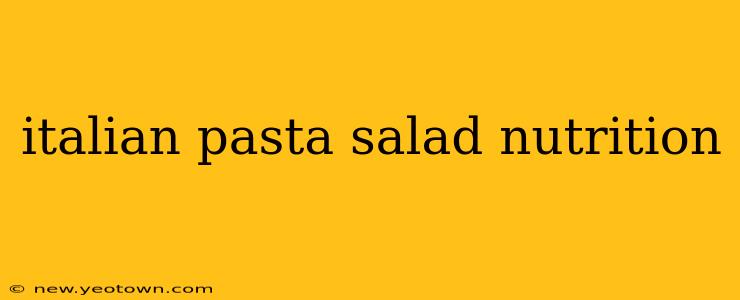Ah, Italian pasta salad! The vibrant colors, the tantalizing aroma of herbs and garlic, the satisfying chew of perfectly cooked pasta… it's a dish that embodies summer gatherings and casual meals alike. But beyond its deliciousness, what's the nutritional story behind this beloved side dish? Let's unravel the ingredients and explore the nutritional benefits (and potential drawbacks) of this classic recipe.
What are the main ingredients in Italian pasta salad?
The beauty of Italian pasta salad lies in its versatility. A typical recipe centers around cooked pasta (usually rotini, farfalle, or penne), a vibrant medley of fresh vegetables like bell peppers, red onion, and cherry tomatoes, and a creamy, tangy dressing. This dressing often features mayonnaise, olive oil, red wine vinegar, garlic, oregano, basil, and sometimes a touch of Parmesan cheese. Other additions, like black olives, artichoke hearts, or salami, can significantly alter the nutritional profile.
How many calories are in a serving of Italian pasta salad?
The calorie count in Italian pasta salad can fluctuate wildly depending on the ingredients and portion size. A standard serving (about a cup) can range from 250 to 500 calories or more. The pasta itself contributes significantly, as does the type of dressing used. A mayonnaise-based dressing will pack in more calories and fat than a lighter vinaigrette. The addition of cheese and meats further increases the caloric density.
Is Italian pasta salad healthy?
This is a complex question, and the answer isn't a simple yes or no. Italian pasta salad can be a healthy part of a balanced diet, but it depends heavily on how it's prepared. The abundant vegetables provide valuable vitamins, minerals, and fiber. Olive oil offers healthy monounsaturated fats. However, the mayonnaise, cheese, and potentially processed meats can elevate the fat, sodium, and saturated fat content. A lighter dressing and the conscious selection of leaner ingredients can significantly boost the overall nutritional value.
What are the nutritional benefits of Italian pasta salad?
When made with wholesome ingredients and a mindful approach to the dressing, Italian pasta salad offers several potential benefits:
- Good source of carbohydrates: Pasta provides energy in the form of carbohydrates.
- Rich in vitamins and minerals: The vegetables contribute a variety of vitamins (like vitamin C and vitamin A) and minerals (like potassium).
- Source of fiber: Vegetables and whole-wheat pasta contribute dietary fiber, promoting digestive health.
- Healthy fats (potentially): Olive oil provides heart-healthy monounsaturated fats.
What are the potential downsides of Italian pasta salad?
On the flip side, certain aspects of Italian pasta salad could raise concerns:
- High in calories and fat: Mayonnaise-based dressings and the addition of cheese and meats can substantially increase the calorie and fat content.
- High in sodium: Processed meats and some dressings can be high in sodium, contributing to potential high blood pressure issues.
- May contain saturated fat: Mayonnaise and cheese contain saturated fat, which should be consumed in moderation.
- Potential for foodborne illness: If not handled and stored properly, Italian pasta salad can be a breeding ground for bacteria.
How can I make a healthier Italian pasta salad?
Creating a healthier Italian pasta salad is achievable with a few simple tweaks:
- Choose whole-wheat pasta: This adds fiber and nutrients.
- Load up on vegetables: Maximize the vegetable-to-pasta ratio for increased vitamins and fiber.
- Opt for a lighter dressing: Use a vinaigrette or a reduced-fat mayonnaise option, or try a combination of both.
- Use lean protein sources: If adding protein, opt for grilled chicken or fish instead of processed meats.
- Control your portion size: Be mindful of how much you're serving yourself.
Italian pasta salad, prepared thoughtfully, can be a delicious and nutritious addition to your diet. By making smart choices about ingredients and portions, you can savor this summer classic without compromising your health goals.

